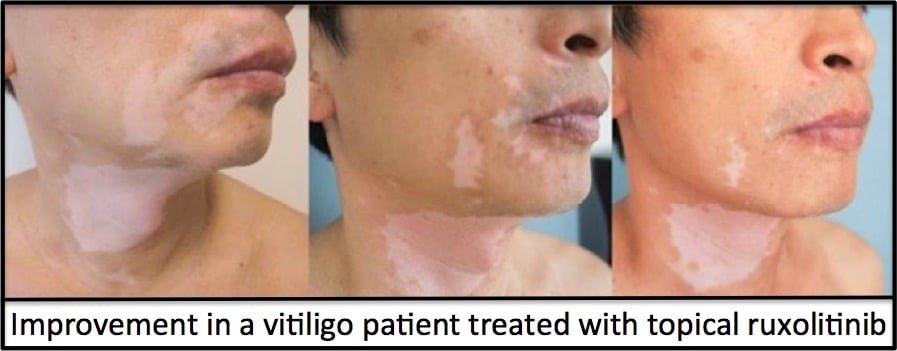Topical JAK inhibitor shown to be effective for facial vitiligo
 Jak inhibitors are all the rage in dermatology, and I recently moderated a symposium at the Society for Investigative Dermatology meeting in Portland that highlighted all the skin diseases for which Jak inhibitors have been used as treatments, including vitiligo, alopecia areata, eczema, and others. I’ve written a number of blogs about using them as a treatment for vitiligo (you can read them here, here, and here), and many of you have asked for updates. So here is one that is particularly exciting, because it includes information about a clinical trial that should be starting soon. A recent study published in the Journal of the American Academy of Dermatology by Dr. David Rosmarin at Tufts University reported that a topical formulation of ruxolitinib 1.5% cream induced significant results in 12 vitiligo patients (see an example in the picture above). It was most effective on the face, and not very effective on the hands (most treatments aren’t). It’s still not clear why it worked best on the face, but we’re working on it. Incidentally Protopic, another topical medication for vitiligo, is also most effective on the face.
Jak inhibitors are all the rage in dermatology, and I recently moderated a symposium at the Society for Investigative Dermatology meeting in Portland that highlighted all the skin diseases for which Jak inhibitors have been used as treatments, including vitiligo, alopecia areata, eczema, and others. I’ve written a number of blogs about using them as a treatment for vitiligo (you can read them here, here, and here), and many of you have asked for updates. So here is one that is particularly exciting, because it includes information about a clinical trial that should be starting soon. A recent study published in the Journal of the American Academy of Dermatology by Dr. David Rosmarin at Tufts University reported that a topical formulation of ruxolitinib 1.5% cream induced significant results in 12 vitiligo patients (see an example in the picture above). It was most effective on the face, and not very effective on the hands (most treatments aren’t). It’s still not clear why it worked best on the face, but we’re working on it. Incidentally Protopic, another topical medication for vitiligo, is also most effective on the face.
Based on these results, the previous positive results using oral Jak inhibitors for vitiligo, and our earlier studies predicting that these drugs would work as treatments in vitiligo, the company that makes ruxolitinib (Incyte) is initiating a Phase II clinical trial to test the topical cream in a number of vitiligo patients. This trial will be a randomized, placebo-controlled trial, which means participants are not guaranteed to get the medicine right away. But there will be multiple doses of the cream tested, so there will be an 80% chance of getting some concentration of the drug when someone is enrolled. After 26 weeks of treatment, participants who received placebo will be given some concentration of the drug to try as well. After 1 year in the trial, all participants will receive the highest concentration of the drug to use for another year.
We are still completing the paperwork for the trial and are not yet recruiting patients, but we are excited to start. I sent out a notice about these results and the trial a few weeks ago in our newsletter to those who are subscribed. If you want to be the first to hear about new clinical trials for vitiligo, including this one, sign up for the newsletter here! In it I will include contact information for all of the study sites, so you can see if there is an opportunity near where you live. So far we know that there will be sites in Worcester (our site), Boston, and Dallas, but there will be others as well. If you are interested in reading more of the details about the trial, you can find them listed here.
I believe that this trial is just the tip of the iceberg. So if you don’t qualify for this trial for some reason, there will be more to come!